After sharing Long Beach Peninsula, then a unique visit to a museum filled with carriages and finally dragging you along for a steep hike and art, it’s time to share my final adventure during my time in the southwest corner of Washington. Interestingly, the final stop was in a different state. Down the peninsula and over the Columbia River is Astoria, Oregon where I found the Columbia River Maritime Museum.
First, can I say how cool the bridge is that spans the Columbia River and connects the two states? It’s long (over 4 miles) and steep (on the Oregon side). At least it’s steep for a bridge. The reason it’s steep is you have to get up high before starting the trek over. Because it’s not a draw bridge, it needed to be tall enough for boats to pass underneath. Before it opened in 1966, people were ferried from one side of the Columbia River to the other.
In a post about the cons of solo travel, I said not getting photos from the van is one. I think about this con almost every time I travel and crossing that bridge was no exception. In other words, I don’t have any photos to share. Although nothing fancy, I wanted a photo of the little green sign in the middle of the bridge welcoming visitors to Oregon/Washington, depending on which way you are traveling.
Two River Museums: A Comparison
One of the museums I explored in Dubuque was all about the Mississippi River, making my visit to the Astoria museum my second river museum. Of course, I cannot help but compare and contrast. Much the same way I did when I visited a cave and then a cavern in two different states.
First, know that they are two very different museums. The Mississippi River museum is huge, in my post I called it a complex. The Columbia River is smaller, simpler and much more sparse.
However, to my sensibility, I actually preferred the Columbia River museum. I found that by not experiencing sensory overload (particularly visual) that I could concentrate on the displays better. I loved the open airy feeling of the displayed boats. Certainly that must be by design. Maybe a psychological way to replicate the open airy feeling of being at sea?
Think of the museum as two halves. First, the open airy side is where full-sized boats are displayed. Then the other half is more artifacts and information, organized into themes such as Naval History, Science of Storms, Mapping, Fishing Canneries and Whaling, and others.
Like the Mississippi River Museum, the Columbia River Museum also had a theater. For a nominal extra fee you enjoy information and education through film. Although I didn’t partake, the movie running during my visit was Aircraft Carrier: Guardians of the Sea and it was in 3D.
My Favorite Boat
Since I know nothing about boats, I cannot say I had a favorite boat based on technical superiority because I’m not educated enough to understand the differences beyond looks.
That said, there was a boat I found quite moving and was the boat I stood in front of the longest. And, it had nothing to do with the boat itself and everything to do with its story.
Do you remember the devastating tsunami that hit Japan in March 2011? The earthquake triggered a tsunami, the fourth largest since 1900 with a 9.0 magnitude. You know that earthquakes happen when tectonic plates shift and Japan’s main island moved 8 feet east during that quake. The resulting tsunami came with waves up to 133 feet. Consequently, nearly 16,000 people died, 10,000 of those were from the tsunami (drowning and blunt force trauma).
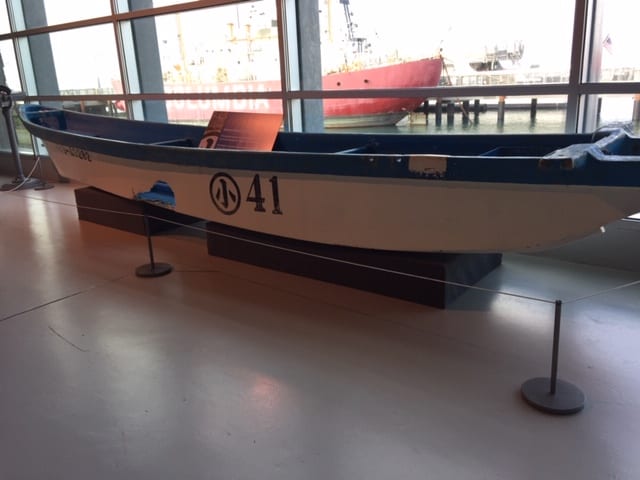
As someone who lived in Alaska for nearly 25 years, I’ll share devastating earthquake insight: it doesn’t fade from memory. The 1964 Alaska earthquake remains the biggest in the US and the second biggest in recorded history in the world. To get an idea of just how massive that is, know that after the 4 minute and 36 second quake, swimming pools in Texas sloshed.
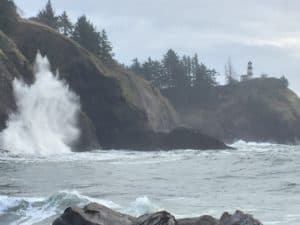
By the time I moved to Alaska that Good Friday event was 30 years in the past and it was 55 years in the past by the time I left. And people still talk about it, sharing vivid memories and detailed experiences of how scary it was. People tell stories of that day, the same way the country tells stories of the Kennedy assassination or the 9/11 terrorist attack. The “where were you when it happened” type of stories.
So, back to Japan. The tsunami hit many fishing villages and many fishermen lost their boats to the sea. But one boat, two years and 5,000 miles later, washed up on the US shore near Cape Disappointment near the mouth of the Columbia River. Beaten up, to be sure, and a hole in the side, it was otherwise intact, with, if you can believe this, several fish living inside.
From the markings on the boat and the aid of the Japanese Consulate, the US contacted the 72-year-old fisherman who’d lost his boat. Katuo Saito happily learned his boat survived but said he didn’t want it returned. That’s how it ended up in the Astoria museum.
And, the resident fish found a home at an Oregon aquarium.
Isn’t that a great story? In addition to the boat and an information board, there is a video story of the event and the aftermath. I stood and watched the entire video. I was simply enthralled.
Maybe it’s the Alaskan in me.
Another Moving Display
I mentioned this display, titled Graveyard of the Pacific, in my introduction to Long Beach where I said that some shipwrecks are now under the beach due to beach growth. And on the subject of shipwrecks, I mentioned the display at the entrance to the museum. The display took its name from what sailors have long-called the area.
Mariners agree that the combination of high seas, a mighty river and shallow, shifting sand bar make the Columbia River Bar one the most dangerous bar crossings in the world.
Columbia River Museum Information Board
If you want an idea of the dangerous waterway, watch this one-minute Coast Guard video I found on YouTube as the crew patrols the mouth of the Columbia River near Cape Disappointment. I got seasick just watching it.
The big display board shows the area and the coastline with little ships in the water. Then on a big interactive information board, you read about a particular ship wreck. The cool part is pushing the button next to the ship’s name lights a ship on the display board so you know where it sunk.
At first I thought the gray board an odd, even dull, choice. But as I thought about it, the somberness of 700 lives and 2,000 ship lost makes the gray color fitting.
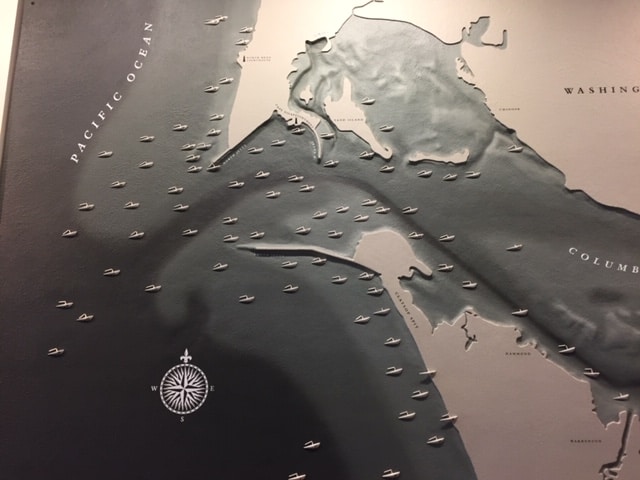
Keep in mind that with so many lost ships, the display board cannot show all of them. The information says the “historic shipwrecks” are the ones you’ll find on the board.
Another Idiom Origin
For those keeping track, I learned where the expression “sleep tight” came from at a museum in Dubuque. I learned where to “keep someone on ice” came from during my visit to the Carriage Museum in Raymond, Washington. So, did I learn a new one at the Columbia River Museum?
Indeed, I did. In Astoria, I added another idiom to the list. “Learning the ropes” is a term that came from life at sea. A sailor had to know the location and function of hundreds of ropes around the ship because pulling the wrong rope could mean disaster. So “learning the ropes” was a critical aspect of life as a seaman.
Today, of course, the expression is no longer limited to ropes. Or the sea.
Boat Tour
Also similar to the Mississippi River Museum, you find a boat outside the Columbia River Museum. During off-season the boat is closed to museum visitors so I didn’t get to see inside. But I got a couple nice photos.
My Favorite Part
They have a little room you can go in to be a weather person on television. You stand in front of a green screen, watch a storm then narrate what’s happening. On the television, the storm comes up behind you. I was a terrible storm narrator, but it was fun to try.
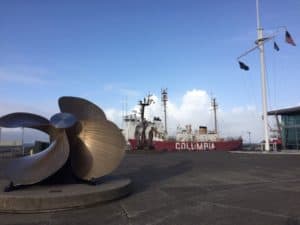
Outside that little room was my absolute favorite part of the museum. The irony of my favorite part is that anyone can go online and see the same thing. But I’d never heard of it so it was all new to me.
The National Oceanic and Atmospheric Administration (NOAA) has a program called Science on a Sphere (SOS). SOS is “a room sized, global display system that uses computers and video projectors to display planetary data onto a six-foot diameter sphere, analogous to a giant animated globe.” It was created as an education tool to help people understand the earth sciences such as ocean temperature, weather, etc. The data is compiled using satellites, ground observations and computer models.
A smaller version is called SOSx where the “x” stands for Explorer. This version of the SOS program is shown on a flat-screen. And the Columbia River Museum had SOSx.
The screen at the museum is giant, probably the size of a movie theater screen, but it seems much bigger because you can walk right up to it. And it was floor to ceiling. Then there are also benches close to the screen for visitors to sit and enjoy. It’s shown in the dark so capturing photos wasn’t possible.
It’s hard to describe. The projected images were various oceanic and atmospheric conditions in real time. The continually moving display is shown as colors, the rainbow colors we are familiar with from the weather segment on local news. But it was beautiful. The flowing dancing colors reminded me of the Aurora Borealis. The Northern Lights.
So, I sat. Transfixed with wonder and awe. It was like when the snake, Kaa, sings to Mowgli in the Disney version of the movie Jungle Book, remember that? The googly eyes? The images were that memorizing.
Because I loved it so much, I turned to the family near me, who were also staring in awe, and said, “It’s art.”
On the NOAA/SOS website, you can find the locations of the museums and science centers that offer SOS. So, if you get the chance, visit one. You won’t be sorry. Now, it’s on my list to see the SOS too, Basically, what I saw on flat-screen in the three dimension of a globe.
For Giggles and Serious Fisherman
In June of 1936, Anthony Canessa caught a record-breaking Chinook salmon, weighing in at 83 pounds. That’s a lot of meals.
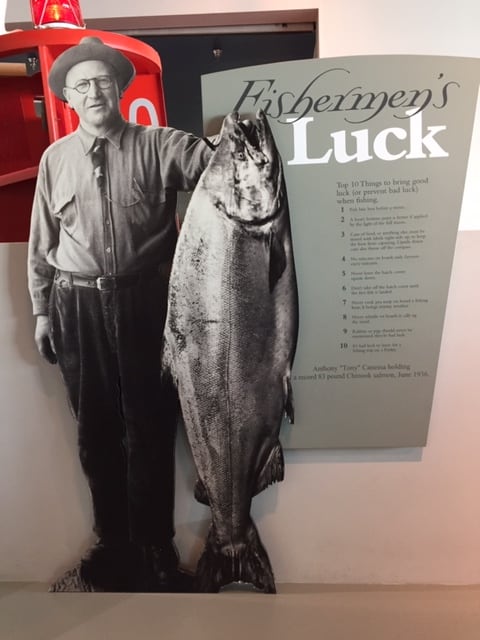
I suppose he was a serious fisherman and, as such, followed all the rules about inviting good luck and avoiding bad luck on that day in 1936. In case you don’t know the rules, let me share:
- Fish bite best before a storm.
- A boat’s bottom paint is better if applied by the light of a full moon.
- Cans of food, or anything else, must be stored with labels right-side up, to keep the boat from capsizing. Upside down cans also throw off the compass.
- No suitcases on board; only farmers carry suitcases.
- Never leave the hatch cover upside down.
- Don’t take off the hatch cover until the first fish is landed.
- Never cook pea soup on board a fishing boat, it brings stormy weather.
- Never whistle on board; it calls up the wind.
- Rabbits or pigs should never be mentioned; they’re bad luck.
- It’s bad luck to leave for a fishing trip on a Friday.
I laughed at most of these. But I found it especially curious that only farmers carry suitcases. I admit, I never thought of farmers as travelers. As a result, I think I need to find a farmers’ museum and see if this is true.
Which ones made you laugh?
Links to Reference SSL Blog Posts Above:
- Long Beach, Washington on the Long Beach Peninsula
- Northwest Carriage Museum
- Willapa National Wildlife Refuge
- Cons of Solo RV Travel
- Museums of Dubuque
- Discovering the Difference Between a Cavern and a Cave
- Deep in the Mountain, High in the Sky: Adventures in Northern Alabama
To see products recently purchased by readers or to browse and shop at Amazon, follow either of these links. As an Amazon Affiliate, I earn from qualifying purchases. So, huge thanks for your support.





You always manage to bring me on the tour with you, which I love. I wonder why they thought a rabbit was bad luck when so many people believe a rabbits foot brings good luck? Love, Marie
It’s funny you should mention that because I had the exact same thought.